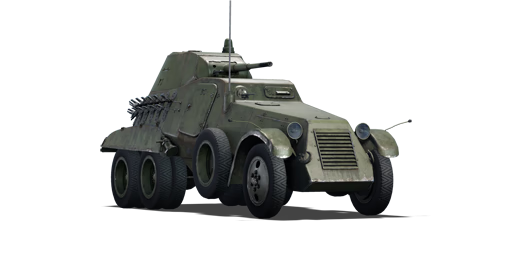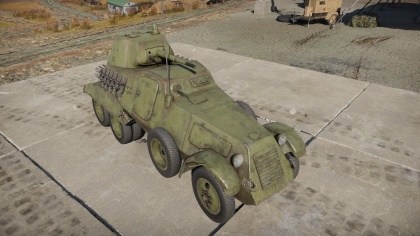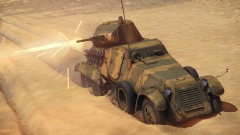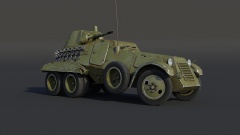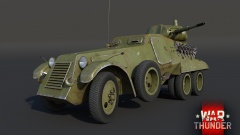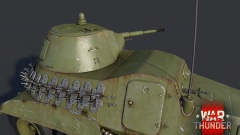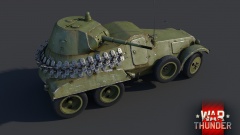Difference between revisions of "BA-11"
Colok76286 (talk | contribs) (→Description: Corrected link) |
Inceptor57 (talk | contribs) (Added to survivability/armour and P&C section) |
||
| Line 12: | Line 12: | ||
=== Survivability and armour === | === Survivability and armour === | ||
<!-- ''Describe armour protection. Note the most well protected and key weak areas. Appreciate the layout of modules as well as the number and location of crew members. Is the level of armour protection sufficient, is the placement of modules helpful for survival in combat? If necessary use a visual template to indicate the most secure and weak zones of the armour.'' The text within these arrows are not to be deleted --> | <!-- ''Describe armour protection. Note the most well protected and key weak areas. Appreciate the layout of modules as well as the number and location of crew members. Is the level of armour protection sufficient, is the placement of modules helpful for survival in combat? If necessary use a visual template to indicate the most secure and weak zones of the armour.'' The text within these arrows are not to be deleted --> | ||
| − | '' | + | |
| + | Armour on the {{PAGENAME}} is unfortunately inadequate against most tank armaments that it can encounter. It's only thick enough to resist rifle-calibre machine guns from coaxials, whereas heavy machine gun rounds have more than enough power to shred the car's body apart. In terms of surviving a front-on encounter with a tank shell, the only hope is that the engine and fuel tank modules will stop the shell from reaching the crew compartment. However, this hope is mired by the fact that the {{PAGENAME}} has the hull-break mechanic enabled, so such a shot can ruin the {{PAGENAME}}. Even so, the shot may immobilize the {{PAGENAME}} and leave it ready for a more accurate follow-up shot to finish the deed. | ||
| + | |||
| + | The only survivability enhancement the {{PAGENAME}} can go through is simply to not get hit. Nearly every compartment of the {{PAGENAME}} has critical components that would cripple the vehicle if not outright destroy it. The front compartment with engine and transmission module can hull-break or immobilise the vehicle. The center driving compartment containing the driver and another crew member, with the transmission right underneath to, again, cripple the vehicle's mobility or activate hull-break. The fighting compartment in the rear with the turret is fully stowed with ammunition with the gun crew, and so a shot there can cause an ammunition detonation that would make short work of the {{PAGENAME}}'s life. | ||
| + | |||
| + | Finally, the roof armour on the {{PAGENAME}} is not sufficient against most type of strafing attacks either, so enemy aircraft going for a gun run will be dangerous to a {{PAGENAME}} user. | ||
'''Armour type:''' | '''Armour type:''' | ||
| Line 175: | Line 180: | ||
=== Pros and cons === | === Pros and cons === | ||
| − | + | <!--Summarise and briefly evaluate the vehicle in terms of its characteristics and combat effectiveness. Mark its pros and cons in a bulleted list. Try not to use more than 6 points for each of the characteristics. Avoid using categorical definitions such as "bad", "good" and the like - use substitutions with softer forms such as "inadequate" and "effective".--> | |
'''Pros:''' | '''Pros:''' | ||
| − | * | + | * Good gun depression of 8 degrees |
| + | * Car forward mobility is quite good off and on-road, so long as it can pick up speed | ||
| + | * Front profile rather small due to its long body | ||
'''Cons:''' | '''Cons:''' | ||
| − | * | + | * Armour is only sufficient against rifle-calibre machine guns, anything more will shred the car apart |
| + | * Roof armour above the crew at its thickest is 8 mm, which allows most aircraft to penetrate with a strafing run | ||
| + | * Interior layout allows any penetrating shot to deal critical damage to something | ||
| + | * Vehicle length means it can present a large target if driving perpendicular to an enemy's gun | ||
| + | * Reverse speed is disappointing, restricting ability to withdraw into cover easily | ||
== History == | == History == | ||
Revision as of 01:35, 18 October 2020
Contents
Description
The BA-11 is a gift premium rank I Soviet light tank
with a battle rating of 1.3 (AB/RB/SB). It was introduced during Update 1.95 "Northern Wind" as a reward for Season 2: Attack from the Sea.
General info
Survivability and armour
Armour on the BA-11 is unfortunately inadequate against most tank armaments that it can encounter. It's only thick enough to resist rifle-calibre machine guns from coaxials, whereas heavy machine gun rounds have more than enough power to shred the car's body apart. In terms of surviving a front-on encounter with a tank shell, the only hope is that the engine and fuel tank modules will stop the shell from reaching the crew compartment. However, this hope is mired by the fact that the BA-11 has the hull-break mechanic enabled, so such a shot can ruin the BA-11. Even so, the shot may immobilize the BA-11 and leave it ready for a more accurate follow-up shot to finish the deed.
The only survivability enhancement the BA-11 can go through is simply to not get hit. Nearly every compartment of the BA-11 has critical components that would cripple the vehicle if not outright destroy it. The front compartment with engine and transmission module can hull-break or immobilise the vehicle. The center driving compartment containing the driver and another crew member, with the transmission right underneath to, again, cripple the vehicle's mobility or activate hull-break. The fighting compartment in the rear with the turret is fully stowed with ammunition with the gun crew, and so a shot there can cause an ammunition detonation that would make short work of the BA-11's life.
Finally, the roof armour on the BA-11 is not sufficient against most type of strafing attacks either, so enemy aircraft going for a gun run will be dangerous to a BA-11 user.
Armour type:
- Rolled homogeneous armour (hull, turret)
- Cast homogeneous armour (turret front, gun mantlet)
| Armour | Front (Slope angle) | Sides | Rear | Roof |
|---|---|---|---|---|
| Hull | 13 mm (27°) Windshield glacis 13 mm (28°) Engine hood glacis 8 mm (28°) Radiator vent 13 mm (57°) Lower glacis |
10 mm (22-27°) Engine hood 13 mm (22-27°) Crew compartment 6 mm Rear wheels arch |
13 mm (24°) Crew compartment 8 mm (7°) Central mudguard |
13 mm (17°) Engine hood 8 mm (3-18°) Crew compartment |
| Turret | 13 mm (cylindrical) Gun mantlet 13 mm (cylindrical) Turret front |
13 mm (21-25°) | 13 mm (24°) | 6 mm |
Notes:
- Wheels are 10 mm thick, add-on tracks are 15 mm thick and mudguards 4 mm thick.
Mobility
| Game Mode | Max Speed (km/h) | Weight (tons) | Engine power (horsepower) | Power-to-weight ratio (hp/ton) | |||
|---|---|---|---|---|---|---|---|
| Forward | Reverse | Stock | Upgraded | Stock | Upgraded | ||
| Arcade | 72 | 65 | 8.1 | 139 | 172 | 17.16 | 21.23 |
| Realistic | 65 | 58 | 80 | 90 | 9.88 | 11.11 | |
Armaments
Main armament
| 45 mm 20-K | Turret rotation speed (°/s) | Reloading rate (seconds) | |||||||||||
|---|---|---|---|---|---|---|---|---|---|---|---|---|---|
| Mode | Capacity | Vertical | Horizontal | Stabilizer | Stock | Upgraded | Full | Expert | Aced | Stock | Full | Expert | Aced |
| Arcade | 114 | -8°/+25° | ±180° | N/A | 15.23 | 21.08 | 25.60 | 28.31 | 30.12 | 3.77 | 3.33 | 3.07 | 2.90 |
| Realistic | 9.52 | 11.20 | 13.60 | 15.04 | 16.00 | ||||||||
Ammunition
| Penetration statistics | |||||||
|---|---|---|---|---|---|---|---|
| Ammunition | Type of warhead |
Penetration @ 0° Angle of Attack (mm) | |||||
| 10 m | 100 m | 500 m | 1,000 m | 1,500 m | 2,000 m | ||
| BR-240 | APHEBC | 70 | 68 | 59 | 50 | 42 | 35 |
| BR-240SP | AP | 73 | 71 | 62 | 52 | 44 | 37 |
| Shell details | |||||||||
|---|---|---|---|---|---|---|---|---|---|
| Ammunition | Type of warhead |
Velocity (m/s) |
Projectile Mass (kg) |
Fuse delay (m) |
Fuse sensitivity (mm) |
Explosive Mass (TNT equivalent) (g) |
Ricochet | ||
| 0% | 50% | 100% | |||||||
| BR-240 | APHEBC | 760 | 1.43 | 1.2 | 9.0 | 29.26 | 48° | 63° | 71° |
| BR-240SP | AP | 757 | 1.43 | N/A | N/A | N/A | 47° | 60° | 65° |
Ammo racks
Last updated: 1.101.0.44
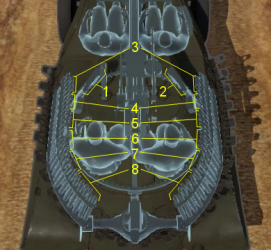
| Full ammo |
1st rack empty |
2nd rack empty |
3rd rack empty |
4th rack empty |
5th rack empty |
6th rack empty |
7th rack empty |
8th rack empty |
Visual discrepancy |
|---|---|---|---|---|---|---|---|---|---|
| 114 | 108 (+6) | 101 (+13) | 85 (+29) | 69 (+45) | 53 (+61) | 37 (+77) | 21 (+93) | 1 (+113) | No |
Notes:
- Shells in racks 1 and 2 (turret) are modeled individually and disappear after having been shot or loaded.
- Shells in racks 3 to 8 (flanks) are modeled by sets of 4 and disappear after all shells in the set having been loaded or shot.
- Racks 3 to 8 deplete symmetrically by sets of 4 shells, starting with the left side.
- Pack 21 (+93) shells (racks 1 to 7 emptied) to go into battle with the turret and the flanks empty of ammo.
Machine guns
| 7.62 mm DT | ||||
|---|---|---|---|---|
| Mount | Capacity (Belt) | Fire rate | Vertical | Horizontal |
| Coaxial | 1,890 (63) | 600 | N/A | N/A |
The small caliber of the DT machine gun makes it largely ineffective against all armoured vehicles but the ones with an open compartment. It still can be used to ping targets as a rangefinding help. The clip capacity of the machine gun is quite poor, as it relies on a magazine of 63 bullets instead of a belt like similar machine guns from other nations.
Usage in battles
Describe the tactics of playing in the vehicle, the features of using vehicles in the team and advice on tactics. Refrain from creating a "guide" - do not impose a single point of view but instead give the reader food for thought. Describe the most dangerous enemies and give recommendations on fighting them. If necessary, note the specifics of the game in different modes (AB, RB, SB).
Modules
| Tier | Mobility | Protection | Firepower | ||
|---|---|---|---|---|---|
| I | Tires | Parts | Horizontal Drive | BR-240SP | |
| II | Suspension | Brake System | FPE | Adjustment of Fire | |
| III | Filters | Crew Replenishment | Elevation Mechanism | ||
| IV | Transmission | Engine | Artillery Support | ||
| This is a premium vehicle: all modifications are unlocked on purchase | |||||
Pros and cons
Pros:
- Good gun depression of 8 degrees
- Car forward mobility is quite good off and on-road, so long as it can pick up speed
- Front profile rather small due to its long body
Cons:
- Armour is only sufficient against rifle-calibre machine guns, anything more will shred the car apart
- Roof armour above the crew at its thickest is 8 mm, which allows most aircraft to penetrate with a strafing run
- Interior layout allows any penetrating shot to deal critical damage to something
- Vehicle length means it can present a large target if driving perpendicular to an enemy's gun
- Reverse speed is disappointing, restricting ability to withdraw into cover easily
History
Armoured cars were one of the most popular world trends in the development of armoured vehicles in the pre-war period. The Soviet heavy armoured vehicle BA-11 was one of the typical examples of this type of vehicle. It was created on the basis of a shortened chassis from the military ZIS-6 - a three-axle off-road truck designed on a scheme of 6x4 (rear wheel drive). The new chassis designed by engineers of the Moscow Automobile Plant was supposed to provide the armoured car greater payload and a better cross-country ability which allows improvements in the armour and a better off-road performance in the vehicle.
Compared to the armoured vehicles of the B-6 and B-10 series which had been designed on the basis of the GAZ-AAA truck, the armour of the BA-11 has been increased by 1.5-2 times and in some places, the BA-11 was slightly better armoured than the T-26 and BT-7 tanks. With the increased weight up to 8 tons, the vehicle maintained good driving characteristics: a speed of up to 64 km/h on the highway and 26 km/h over terrain. As well as in the BA-10 the designers also provided overall tracks which were able to help the armoured car to overcome particularly difficult areas. The gun and the turret of the vehicle also receives a 45 mm 20-K cannon from the BA-10 in the turret.
The heavy BA-11 armoured vehicle was produced in limited edition in 1939 and participated in battles at the early stages of WWII. In 1942 it was withdrawn from service.
- From Devblog
Media
- Skins
- Images
Bicolor summer camouflage, reward during the WWM Season 2: Attack from the Sea
- Videos
See also
Links to the articles on the War Thunder Wiki that you think will be useful for the reader, for example:
- reference to the series of the vehicles;
- links to approximate analogues of other nations and research trees.
External links
| USSR light tanks | |
|---|---|
| T-26 | T-26 · T-26 (1st Gv.T.Br.) · T-26-4 · T-26E |
| BT | BT-5 · RBT-5 · BT-7 · BT-7 TD · BT-7M · BT-7A (F-32) |
| T-50 | T-126 · T-50 |
| T-70 | T-70 · T-80 |
| PT-76 | PT-76B · PT-76-57 · Object 906 |
| BMP | BMP-1 · BMP-2 · BMP-2M · BMP-3 |
| BMD | BMD-4 |
| 2S25 | 2S25 · 2S25M |
| Wheeled | BA-11 · BTR-80A |
| Other | T-60 · Object 685 · 2S38 |
| China | ▂Type 62 |
| USSR premium ground vehicles | |
|---|---|
| Light tanks | BA-11 · RBT-5 · BT-7A (F-32) · T-26 (1st Gv.T.Br.) · T-26E · T-126 · PT-76-57 · 2S38 |
| Medium tanks | T-34 (Prototype) · T-34 (1st Gv.T.Br.) · T-34E · T-34-57 (1943) · T-34-85E · T-34-100 · T-44-122 · TO-55 · T-55AM-1 · T-72AV (TURMS-T) · T-80UD · Т-80U-Е1 |
| ▂M3 Medium · ▂M4A2 · ▂T-III · ▂T-V · ▂МК-IX "Valentine" | |
| Heavy tanks | SMK · T-35 · ▂MK-II "Matilda" · KV-1E · KV-2 (1940) · KV-2 (ZiS-6) · KV-122 · KV-220 · IS-2 "Revenge" · Object 248 · IS-6 · T-10A |
| Tank destroyers | BM-8-24 · BM-13N · BM-31-12 |
| SU-57 · SU-76D · SU-76M (5th Gv.Kav.Corps) · SU-85A · SU-100Y · SU-122P · Object 120 | |
| SPAA | ▂Phòng không T-34 · ZUT-37 |


